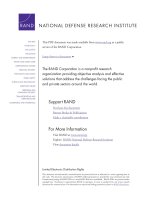UNDERSTANDING BIOTECHNOLOGY
Bạn đang xem bản rút gọn của tài liệu. Xem và tải ngay bản đầy đủ của tài liệu tại đây (3.77 MB, 431 trang )
acq45005_fm.qxd 2/26/03 4:15 PM Page i
Understanding
Biotechnology
An Integrated and Cyber-Based Approach
acq45005_fm.qxd 2/26/03 4:15 PM Page ii
This page intentionally left blank
acq45005_fm.qxd 2/26/03 4:15 PM Page iii
Understanding
Biotechnology
An Integrated and Cyber-Based Approach
George Acquaah
Langston University
Upper Saddle River, New Jersey 07458
acq45005_fm.qxd 2/27/03 2:24 PM Page iv
Library of Congress Cataloging-in-Publication Data
Acquaah, George.
Understanding biotechnology: an integrated and cyber-based approach / by George
Acquaah.—1st ed.
p. cm.
Includes bibliographical references and index.
ISBN 0-13-094500-5
1. Biotechnology. I. Title.
TP248.2 .A275 2004
660.6—dc21
2002190731
Editor-in-Chief: Stephen Helba
Executive Editor: Debbie Yarnell
Development Editor: Kate Linsner
Managing Editor: Mary Carnis
Production Editor: Amy Hackett, Carlisle Publishing Services
Production Liaison: Janice Stangel
Director of Manufacturing and Production: Bruce Johnson
Manufacturing Buyer: Cathleen Peterson
Creative Director: Cheryl Asherman
Cover Design Coordinator: Miguel Ortiz
Marketing Manager: Jimmy Stephens
Cover Design: Amy Rosen
Cover Illustration: Genetic Transformation of Cassava. Courtesy of Nigel J. Taylor.
Pearson Education LTD.
Pearson Education Australia PTY, Limited
Pearson Education Singapore, Pte. Ltd
Pearson Education North Asia Ltd
Pearson Education Canada, Ltd.
Pearson Educatión de Mexico, S. A. de C. V.
Pearson Education—Japan
Pearson Education Malaysia, Pte. Ltd
Copyright © 2004 by Pearson Education, Inc., Upper Saddle River, New Jersey 07458. All rights reserved.
Printed in the United States of America. This publication is protected by Copyright and permission should be obtained
from the publisher prior to any prohibited reproduction, storage in a retrieval system, or transmission in any form or by
any means, electronic, mechanical, photocopying, recording, or likewise. For information regarding permission(s), write
to: Rights and Permissions Department.
10 9 8 7 6 5 4 3 2 1
ISBN: 0-13-094500-5
acq45005_fm.qxd 2/26/03 4:15 PM Page v
To Theresa. . . . He who finds a good wife finds a good thing!
acq45005_fm.qxd 2/26/03 4:15 PM Page ii
This page intentionally left blank
acq45005_fm.qxd 2/27/03 12:47 PM Page vii
Contents
Preface xxiii
Acknowledgements: xxvii
1
Part
2
What Is Biotechnology?
1
Purpose and Expected Outcomes
1
Introduction 1
What’s in a Name? 2
Biotechnology Takes Academia by Storm 2
The Public Weighs in on the Biotech Debate 3
The “Old” versus the “New” Biotechnology 3
Biotechnology Timeline 4
Why Is Biotechnology Such a Big Deal? 4
Biotechnology Can Be Abused 6
Cyber-based Introductory Materials 7
Using the Internet Material in this Textbook 7
Key Concepts 7
Outcomes Assessment 8
Additional Questions and Activities 8
References and Suggested Reading 8
I
Brief Review of the Underlying
Science
The Nature of Living Things: How They
Are Organized
11
12
Purpose and Expected Outcomes 12
Brief Taxonomy of Living Things 12
Levels of Eukaryotic Organization 12
The Cell 13
Subcellular Organization 14
Types of Cellular Molecules 14
Key Concepts 22
Outcomes Assessment 23
Additional Questions and Activities 23
Internet Resources 23
References and Suggested Reading 25
3
The Nature of Living Things: How They Function
26
Purpose and Expected Outcomes 26
Genetic Basis of Function 26
What Is the Central Dogma? 26
DNA Replication 27
vii
acq45005_fm.qxd 2/27/03 12:47 PM Page viii
viii
Contents
DNA Transcription 29
Translation of mRNA (Peptide Synthesis) 31
Cellular Metabolism 36
Photosynthesis 36
Cellular Respiration 40
Growth and Development 42
Key Concepts 43
Outcomes Assessment 45
Additional Questions and Activities 45
Internet Resources 46
References and Suggested Reading 46
4
5
The Nature of Living Things: Genetic Behavior
48
Purpose and Expected Outcomes 48
Genotype versus Phenotype 48
Number of Genes Encoding a Trait 48
Genome Variations 49
Mutations 49
Transposable Genetic Elements 51
Regulation of Gene Expression 52
Regulation of Gene Expression in Prokaryotes 52
The Operon and Operon Model 54
Regulation of Gene Expression in Eukaryotes 54
Potential Control Levels of Eukaryotic Gene Expression 55
Regulation of Transcription 56
Regulation of RNA Processing 57
Regulation of mRNA Transport 57
Regulation of mRNA Stability 58
Regulation of Translation 58
Regulation of Protein Activity 58
Key Concepts 58
Outcomes Assessment 59
Additional Questions and Activities 59
Internet Resources 60
References and Suggested Reading 61
Principles of Genetic Manipulation of Organisms:
Conventional Approach
62
Purpose and Expected Outcomes 62
The Basic Principle of Genetic Manipulation 63
General Steps in Breeding 63
Breeding Objectives 63
Heritable Variation 64
Recombination 64
Selection 65
Limitations of Conventional Breeding 65
What About Plants That Do Not Reproduce Sexually? 68
The Importance of Conventional Breeding to Biotechnology 68
Key Concepts 69
acq45005_fm.qxd 2/27/03 12:47 PM Page ix
Contents
ix
Outcomes Assessment 70
Internet Resources 70
References and Suggested Reading 70
6
Principles of Genetic Manipulation of Organisms:
Recombinant DNA (rDNA) Technology
72
Purpose and Expected Outcomes 72
General Steps in rDNA Procedure 72
Restriction Endonucleases: Cutting DNA 73
Gene Isolation 74
Cloning Vectors 75
Plasmid Cloning Vectors 75
Viral Vectors 76
Vectors for Cloning Very Large DNA Fragments 78
Bacterial Transformation 79
Transgene Delivery 80
Direct Gene Transfer 81
Microinjection 82
Mediated (Indirect) Gene Transfer 82
Tissue Culture and Selection 85
Tissue Culture 86
Selection Systems 86
Transgene Integration 89
Transgene Expression 89
Constitutive Promoters 90
Tissue-Specific and Developmentally Regulated Promoters 91
Inducible Promoters 91
Stability of Transgene Expression 91
Marker-Independent Transgenic Production 92
Key Concepts 92
Outcomes Assessment 93
Additional Questions and Activities 93
Internet Resources 93
References and Suggested Reading 94
Part
7
II
Enabling Technologies
of Biotechnology
Cell and Tissue Culture
Purpose and Expected Outcomes 96
Concept of Totipotency 96
Environmental Requirements for Tissue Culture—Overview 97
Culture Medium 98
Micropropagation 99
Shoot and Node Culture 100
Organogenesis 101
Nonzygotic Embryogenesis 101
Protoplast Culture 102
Somatic Hybridization 103
95
96
acq45005_fm.qxd 2/27/03 12:47 PM Page x
x
Contents
Animal Tissue and Culture 103
Key Concepts 104
Outcomes Assessment 104
Internet Resources 104
References and Suggested Reading 105
8
Electrophoresis and Blotting
9
Molecular Markers
10
106
Purpose and Expected Outcomes 106
What Is Electrophoresis? 106
Role of Electrical Current and Charge 106
Support Systems 107
Visualization 107
Two-Dimensional (2-D) Electrophoresis 109
Capillary Electrophoresis 110
Blotting 111
Southern Blot 111
Northern Blot 113
Dot Blot 114
Electroblotting 114
Western Blot 114
Key Concepts 114
Outcomes Assessment 115
Additional Questions and Activities 115
Internet Resources 115
References and Suggested Reading 116
117
Purpose and Expected Outcomes 117
Types of Markers 117
Molecular Markers 118
Restriction Fragment Length Polymorphisms (RFLPs) 118
Random Amplified Polymorphic DNA (RAPD) 119
DNA Amplification Fingerprinting (DAF) 120
Simple Sequence Repeats (SSRs) 120
AFLP 120
Single Nucleotide Polymorphisms (SNPs) 121
Marker-Assisted Selection 122
Plant Cultivar Identification 122
Conventional Breeding (and Linkage Mapping) 122
Markers for Selection in Transformation Studies 123
Key Concepts 124
Outcomes Assessment 124
Internet Resources 124
References and Suggested Reading 125
The Polymerase Chain Reaction (PCR) and DNA
Synthesis
126
Purpose and Expected Outcomes 126
What Is PCR? 126
acq45005_fm.qxd 2/26/03 4:15 PM Page xi
Contents
xi
Conducting PCR 126
The PCR Sample 126
The PCR Mixture 127
The PCR Cycle 127
The PCR Detection and Analysis 128
Advances in PCR Technology 130
Selected Uses 130
PCR-based Markers 130
Chemical Synthesis DNA 131
Applications of DNA Synthesis 131
Steps in DNA Synthesis 131
Key Concepts 132
Outcomes Assessment 133
Internet Resources 133
References and Suggested Reading 133
11
Genome Mapping and DNA Sequencing
12
Storage and Retrieval of Genetic Information
134
Purpose and Expected Outcomes 134
Comparative Scale of Mapping 134
Karyotype 135
Genome Mapping 135
Genetic Linkage Maps 135
Physical Maps 136
Approaches to Genome Mapping 137
Bottom-up Mapping 137
Top-down Mapping 138
Chromosome Walking 138
Methods of DNA Sequencing 139
Partial versus Whole Genome Sequencing 141
Automated Sequencing 141
Haplotype Mapping 143
Key Concepts 143
Outcomes Assessment 144
Internet Resources 144
References and Suggested Reading 144
Purpose and Expected Outcomes 145
Storing Actual DNA 145
Genomic Libraries 145
cDNA Libraries 146
Retrieving Genes from Storage (Screening Gene Libraries) 147
DNA Colony Hybridization 147
Immunological Assay 149
Computer-based Storage and Retrieval of Genetic
Information 149
Key Concepts 150
Outcomes Assessment 150
Internet Resources 150
References and Suggested Reading 150
145
acq45005_fm.qxd 2/27/03 12:47 PM Page xii
xii
Contents
Part
13
III
Approaches of Biotechnology
Structural Genomics
151
153
Section 1: Genome Sequencing 153
Purpose and Expected Outcomes 153
Genome Sequencing 153
The Human Genome Project 153
Methodologies 154
Completeness of a Sequenced Genome 157
The Private Sector Sequencing Strategy 157
Summary of Information from the Draft of the Human
Genome 158
Impact of the Human Genome Project 159
After Sequencing, What Next? 159
Comparative Genomics 160
General Characteristics of Model Organisms 160
Brief Status of Model Organisms 161
Key Concepts 163
Outcomes Assessment 163
Internet Resources 163
References and Suggested Reading 164
Section 2: Protein Structure Determination 164
Purpose and Expected Outcomes 164
The Complexity of Proteins 164
Operational Strategy Protein Structure Determination 166
Basic Method of Protein Structure Determination 166
X-ray Crystallography 167
Nuclear Magnetic Resonance 167
Steps in Protein Structure Prediction 168
General Considerations of Protein Modeling 168
Comparative Structure Prediction 169
De novo Structure Prediction 169
Applications and Benefits of Protein Structure Models 169
Key Concepts 170
Outcomes Assessment 171
Internet Resources 171
References and Suggested Reading 171
14
Functional Genomics
Section 1: Bioinformatics 172
Purpose and Expected Outcomes 172
What Is Bioinformatics? 172
The Principles of Computational Biology 173
Resources for Bioinformatics Projects 173
Types of Bioinformatics Databases 175
Accessing and Using Web-based Resources 176
Protein Databases 176
172
acq45005_fm.qxd 2/26/03 4:15 PM Page xiii
Contents
xiii
Sequence Retrieval Systems 176
The Properties of a Gene-seeking Computer Software 176
Sequential Alignment and Searching of Databases 177
Comparing Sequences against a Database 178
What the Search Results Mean 178
Key Concepts 179
Outcomes Assessment 179
Internet Resources 179
References and Suggested Reading 180
Section 2: DNA Microarrays 180
Purpose and Expected Outcomes 180
What Are DNA Microarrays? 180
Design Formats 181
Microarray Fabrication 181
Design and Implementation of a DNA Microarray
Experiment 182
Applications of DNA Microarrays 184
Gene Expression 184
Steps in Gene Expression Analysis with DNA
Microarrays 184
Drug Discovery and Development 184
Sequence Identification 186
Key Concepts 186
Outcomes Assessment 186
Internet Resources 187
References and Suggested Reading 187
Section 3: Proteomics 187
Purpose and Expected Outcomes 187
What Is Proteomics? 188
The Challenges of Studying Proteins 188
Frontline Technologies of Proteomics 189
Two-dimensional Gel Electrophoresis 190
Yeast Two-hybrid Assay 190
X-ray Crystallography 191
Mass Spectrometry of Biomolecules 192
Other Functional Genomics Tools 194
Metanomics 194
Gene Knockout and Knockin Technologies 195
Reverse Genetics 195
Insertional Mutagenesis (Transposons/T-DNA) 197
Loss-of-function Mutations 197
Enhancer Trapping 197
Activation Tagging 197
Synteny 198
Key Concepts 198
Outcomes Assessment 199
Internet Resources 199
References and Suggested Reading 199
acq45005_fm.qxd 2/27/03 12:47 PM Page xiv
xiv
Contents
15
Modifying Protein Production and Function
200
Section 1: Protein Engineering 200
Purpose and Expected Outcomes 200
What Is Protein Engineering? 200
Why Engineer Proteins? 201
Steps in Protein Engineering 201
Protein Engineering Activities 202
Selected Applications 204
Key Concepts 204
Outcomes Assessment 204
Internet Resources 205
References and Suggested Reading 205
Section 2: Antisense Technology 205
Purpose and Expected Outcomes 205
What Is the Antisense Technology? 205
Synthetic Oligonucleotides 206
Antisense Oligos Delivery 207
Naturally Occurring Antisense RNA 207
Down-regulation of Gene Expression 208
Transcriptional Gene Silencing 208
Post-transcriptional Gene Silencing 208
Selected Application in Plants: The Making of the Flavr Savr
Tomato 209
Selected Application in Industry 210
Antisense Therapeutics 210
Key Concepts 212
Outcomes Assessment 212
Internet Resources 213
References and Suggested Reading 213
Part
16
IV
Specific Applications
Food Biotechnology
Section 1: Plants 216
Purpose and Expected Outcomes 216
Overview of Plant Food Biotechnology 216
Engineering Ice Protection: The Case of “Ice Minus” 217
Engineering Fruit Ripening 218
The Flavr Savr Tomato 218
Engineering Insect Resistance 219
Protein Toxins from Bacillus thuringiensis (Bt) 219
The StarLink Controversy 220
Engineering Viral Resistance 221
Engineering Herbicide Resistance 221
Why Engineer Herbicide-resistant Crops? 221
Modes of Action and Herbicide-resistance Mechanisms 222
215
216
acq45005_fm.qxd 2/26/03 4:15 PM Page xv
Contents
xv
Molecular Methods of Weed Control 222
Modification of the Target of the Herbicide 222
Herbicide-tolerant Genes 223
Engineering Nutritional Quality 225
The Making of “Golden Rice” 225
Other Selected Applications 227
Commercial Plant Products 228
Key Concepts 228
Outcomes Assessment 230
Internet Resources 230
References and Suggested Reading 230
Section 2: Animals and Microbes 231
Purpose and Expected Outcomes 231
Overview of Animal Food Biotechnology 231
Engineering Growth Hormones 231
Cloning Animals 232
Applications in Aquaculture 234
Enhancing the Use of Feed by Animals 234
Probiotics 234
Microbial Applications in Development of Food Products 235
Traditional Microbiological Industries 235
Key Concepts 237
Outcomes Assessment 238
Internet Resources 238
References and Suggested Reading 239
17
Human Health and Diagnostics
Section 1: Applications in Medicine 240
Purpose and Expected Outcomes 240
Gene Therapy 240
Forms of Gene Therapy 241
Methods of Gene Therapy 241
Tools for Gene Therapy 241
Viral Delivery Systems 241
Tools for Targeted Gene Repairs 242
Status of Gene Therapy 243
Challenges of Gene Therapy 244
DNA/RNA Vaccines 244
Immune Response 244
Conventional Vaccines 245
Genetic Vaccines 245
The Human Genome Project 246
DNA Profiling 246
Testing for Genetic Disorders 248
Genetic Counseling 249
Pharmacogenetics 249
Improved Doctor Prescriptions 249
Allele-specific Nucleotides 249
Drug Development 250
240
acq45005_fm.qxd 2/27/03 12:47 PM Page xvi
xvi
Contents
Stem Cells 250
Producing Pluripotent Stem Cells 251
Adult Stem Cells 251
Potential Applications of Pluripotent Stem Cells 252
Challenges with Cell Therapy Using Pluripotent Stem Cells 252
Stem Cell Business 252
Animal Farming for Cells and Organs 252
Key Concepts 253
Outcomes Assessment 254
Internet Resources 254
References and Suggested Reading 254
Section 2: Forensic Applications 255
Purpose and Expected Outcomes 255
What Is DNA Profiling? 255
Sources of DNA for Forensics 255
Methods of Analysis 256
Variable Number Tandem Repeats 256
PCR-based DNA Profiling 258
RFLP- versus PCR-based DNA Profiling 259
The Role of Ethnic Group Data in DNA Profiling 259
Pitfalls in Interpretation of DNA Profiling Results 260
Selected Applications of DNA Profiling 260
Key Concepts 261
Outcomes Assessment 261
Internet Resources 262
References and Suggested Reading 262
18
Industrial Applications
Section 1: Bioprocessing 263
Purpose and Expected Outcomes 263
What Is a Bioprocess? 263
Putting Biotechnology to Work 263
Engineering Innovation 264
Enabling Technologies 264
Economic Opportunity 264
Bioprocess Engineering 264
Pretreatment 264
Bioreactor Fluids 265
Media Sterilization 265
Growth Media 266
Microbial Growth 266
Microbial Culture Systems in Bioreactors 268
Batch versus Continuous Fermentation 268
Factors Affecting the Fermentation Process 269
Bioreactors 269
Downstream Processing 272
Chromatography 274
Drying 274
Key Concepts 274
263
acq45005_fm.qxd 2/26/03 4:15 PM Page xvii
Contents
xvii
Outcomes Assessment 275
Internet Resources 275
References and Suggested Reading 275
Section 2: Microbial-based Bioprocessing Pharming 276
Purpose and Expected Outcomes 276
Industrial Ethanol 276
Bulk Chemicals 276
Industrial Enzymes 277
Waste Treatment 277
Pharming 278
Animal Pharming 278
Plant-based Pharming 280
Key Concepts 281
Outcomes Assessment 281
Internet Resources 282
References and Suggested Reading 282
Section 3: Biosensors 282
Purpose and Expected Outcomes 282
What Are Biosensors? 282
Membranes Used in Biosensors 283
The Role of Transducers in Biosensors 284
Bioaffinity Sensors 284
Whole Cell Biosensors 284
General Considerations 285
Commercial Forms of Biosensors 285
Applications of Biosensors 286
Key Concepts 287
Outcomes Assessment 287
Internet Resources 287
References and Suggested Reading 287
Section 4: Recovering Metals 288
Purpose and Expected Outcomes 288
What Is Bioaccumulation? 288
Examples of Bioaccumulation 288
Methods of Metal Removal 289
Biotechnology for Mineral Extraction 289
Mechanisms of Biomining 290
Types of Bioleaching Processes 290
Desulfurization of Coal 291
Key Concepts 291
Outcomes Assessment 291
Internet Resources 292
References and Suggested Reading 292
19
Environmental Applications
Purpose and Expected Outcomes 293
Environmental Concerns of Biotechnology Applications 293
Environmental Applications 294
Bioremediation 294
293
acq45005_fm.qxd 2/26/03 4:15 PM Page xviii
xviii
Contents
Waste Management 295
Diagnostic Tools 295
Phytoremediation 296
Biofertilizers 296
Complementing Biological Control 296
Indirect Benefits through Agricultural Applications 297
Key Concepts 297
Outcomes Assessment 298
Internet Resources 298
References and Suggested Reading 298
Part
20
V
Social Issues
299
Rights and Privileges
300
Section 1: Intellectual Property 300
Purpose and Expected Outcomes 300
Intellectual Property: Definition and Protection 300
Copyrights 300
Confidential Information 300
Breeders’ Rights 301
Trademarks 301
Patents 301
Patents 301
What Is a Patent? 301
The Importance of a Patent 302
What Can Be Patented? 302
Types of Patents 302
National and International Patents 303
Scope of Protection 303
Criteria for Patentability 303
Applying for a Patent 304
Exploiting Intellectual Property 304
Patents in Biotechnology: Unique Issues and Challenges 305
Key Concepts 307
Outcomes Assessment 307
Internet Resources 307
References and Suggested Reading 307
Section 2: Ethical Implications 308
Purpose and Expected Outcomes 308
The Biotechnology Debate 308
Introduction to Ethics 309
Biotechnology and Ethics 309
Social Concerns 310
Public Acceptance of Biotechnology 311
Key Concepts 312
Outcomes Assessment 312
Internet Resources 312
References and Suggested Reading 312
acq45005_fm.qxd 2/26/03 4:15 PM Page xix
Contents
xix
21
22
Risks and Regulations
313
Purpose and Expected Outcomes 313
The Complexity of Risk Analysis 313
Regulation of Biotech Products 314
USDA-APHIS 315
FDA 315
EPA 316
The Issue of Food Allergens in GM Foods 316
The Concept of Substantial Equivalence in the Regulation of
Biotechnology 317
The Issue of “Novel Trait” 318
The Precautionary Principle 319
Regulation and the Issue of Public Trust 319
Example of Safety Assessment 320
The Product 320
The Environmental Assessment of YieldGuard 321
Safety Assessment of the cry1Ab Protein 321
Compositional Analysis of Corn Grain and Forage 321
Environmental Impact 322
Biosafety Regulation at the International Level 322
Labeling of Biotech Products 323
Economic Impact of Labeling and Regulations 324
Key Concepts 324
Outcomes Assessment 325
Internet Resources 325
References and Suggested Reading 325
Biotechnology as a Business
Section 1: The Concept of a Biotechnology Company 326
Purpose and Expected Outcomes 326
The Origin of the Business Concept 326
Biotechnology Business Models 327
Product Development Companies 327
Platform Technology Development Companies 328
What Is the Best Business Model? 329
Starting a Biotechnology Business 330
Business Planning 330
The Role of People in a Business 332
The Issue of Technology 333
Financing a Biotech Business 333
Marketing Biotechnology Products 334
The Importance of Business Identity 335
Structuring the Biotech Business for Sustainable
Profitability 335
The Question of Integration 335
The Start of a Biotech Company: The Amgen Story 336
Key Concepts 337
Outcomes Assessment 338
326
acq45005_fm.qxd 2/26/03 4:15 PM Page xx
xx
Contents
Internet Resources 338
References and Suggested Reading 338
Section 2: The Role of Management 338
Purpose and Expected Outcomes 338
What Is Management? 339
General Functions of a Manager 339
Organizational Structure of a Company 339
The Manager as a Decision Maker 340
The Importance of a Strategic Decision 340
Types of Decisions 340
Marketing-based Decisions 341
Decisions Concerning the External Business Environment 342
Key Concepts 342
Outcomes Assessment 342
Internet Resources 343
References and Suggested Reading 343
Section 3: Recent Business Dynamics 343
Purpose and Expected Outcomes 343
Biotechnology and the Private Sector 343
The Forces Behind the Changes 344
Farm-level Production Issues 345
Approved GM Agricultural Products 345
Realized Profitability of GM Crops to the Producer 345
Consumer-level Economic Issues 346
Key Concepts 347
Outcomes Assessment 347
Internet Resources 347
References and Suggested Reading 348
Section 4: Jobs in Biotechnology 348
Purpose and Expected Outcomes 348
Direct versus Indirect Jobs 348
Direct Jobs 348
Indirect Jobs 348
Jobs in a Biotechnology Company 349
Science-based Academic Training for Biotech Jobs 349
Formal Training for a Degree 350
Informal Training 350
Specialized Training 350
Discipline-based Academic Training in Science 350
Non-science-based Academic Training for Biotech Jobs 351
Training in Related Sciences for Biotech Jobs 351
Types of Biotech Employers 351
Key Concepts 352
Outcomes Assessment 353
Internet Resources 353
References and Suggested Reading 353
acq45005_fm.qxd 2/27/03 12:47 PM Page xxi
Contents
xxi
23
Biotechnology and Developing Economies
24
Perceptions and Fears about Biotechnology
354
Purpose and Expected Outcomes 354
Overview of World Food Issues 354
Barriers to the Commercializing of Biotech in Developing
Countries 355
The Role of International Initiatives in Biotechnology 357
Efforts by Independent Nations (Bilateral Donors) 357
Tripartite 358
Private Foundations 360
The United Nations System 360
Status of Biotechnology in Selected Developing Countries 361
Brazil 361
China 361
India 362
Kenya 362
Key Concepts 362
Outcomes Assessment 363
Internet Resources 363
References and Suggested Reading 364
365
Section 1: Contrasting Public and Scientific Perceptions 365
Purpose and Expected Outcomes 365
The Difficulty of Contrasting Perceptions of Technology 365
The Techniques of Biotechnology Are Alien
and Too Radical 366
Genetic Engineering Is an Exact Science 366
Nontargeted Pesticide Resistance in the Ecosystem as a Result of the
Use of Biotech Crops Is Unavoidable 367
Biotechnology Crop and Animal Production and Use Has Potentially
Adverse Effects on Biodiversity 368
Biotechnology Products Are Unnatural and Unsafe 368
Postscript 368
Key Concepts 369
Outcomes Assessment 369
Internet Resources 369
Section 2: Bioterrorism 370
Purpose and Expected Outcomes 370
What Is Bioterrorism? 370
Nature’s Version of Biowarfare 370
Biological Weapons 371
Potential Biowarfare Agents 371
Anthrax 372
Smallpox 372
Plaque 372
Q Fever 372
acq45005_fm.qxd 2/27/03 12:47 PM Page xxii
xxii
Contents
Botulism 372
Brucellosis 372
Tulasemia 372
Historical Perspectives of Biowarfare 373
Requirements for Making a Biological Weapon 373
How Real Is a Threat from Biological Warfare? 374
International Agreements 374
Protecting the Public against Biological Weapons 374
The Role of Biotechnology in Bioterrorism 375
Key Concepts 375
Outcomes Assessment 376
Internet Resources 376
References and Suggested Reading 376
25
Part
Biotechnology: The Future
377
Purpose and Expected Outcomes 377
Technological Advances in the Pipeline 377
Genomics Technologies 377
Proteomics 378
Marker-free Transformation 379
Apomixis 379
Plastid Engineering 380
Bioinformatics 380
Bridging the Biotechnology Divide: Third World Participation in
Biotechnology 380
Applications 381
Agriculture 381
Medicine 382
Industrial 382
Environmental 383
Business 383
Social Issues 383
Key Concepts 383
Outcomes Assessment 384
Internet Resources 384
References and Suggested Reading 385
VI
Additional Resources
Selected Biotechnology Websites
386
387
Glossary
389
Index
399
acq45005_fm.qxd 2/26/03 4:15 PM Page xxiii
Preface
B
iotechnology is such a rapidly evolving field that perhaps the only way it makes sense
to have a textbook on the subject is for the author and publisher to plan to annually
update it. Unless, of course, a strategy such as the one adopted in this textbook is followed, whereby the textbook is linked to the very wheels of the vehicle for modern information dissemination—the Internet. In other words, a cyber-based approach is critical to
continually keeping a biotechnology textbook current. Without question, there is a
tremendous need for textbooks in biotechnology to inform and to instruct. Even though
the Internet is currently the most important Information Age technology, we do not carry
computers with us all the time, nor would we want to stare at a computer screen all the
time even if we did carry one. There is a role for the written word in the Information Age
that cannot be replaced by computers.
Notwithstanding the rapid rate of its evolution, biotechnology evolves around certain core principles and practices. A textbook on the subject should, therefore, first emphasize these core principles and practices, which are relatively immutable and time
honored, and then allow room for growth through planned revisions. Methodologies
that are deemed to be “standard” today may be obsolete tomorrow. Even so, it is informative and instructive to understand the evolution of the technologies of biotechnology. Such knowledge guides and stimulates the development of newer technologies.
Furthermore, new technology does not become assimilated into the tradition of science
overnight. Some older technologies, the proverbial “old reliables,” are still depended
upon in certain cases for a variety of reasons. For example, isozyme technology is an older
technology that is still used in research and industry as a quick and inexpensive means
of authenticating the hybridity of a cross, among other uses. In situations where resources are limited, as well as in small-scale studies, older technologies may sometimes
be more economical and convenient to use than newer ones.
The Internet currently provides the most expansive forum for the exchange of ideas.
It is a playground for both amateurs and professionals, for “sowing wheat and tares,” to
borrow from the Bible. Without specific guidance, an Internet user has to spend considerable time to sort through the tremendous volume of information available to find useful data. Obviously, a textbook that is supported by a quick guide to supplemental
material on the Internet would be very attractive and desirable. This book is supported
by such a website guide to important and informative sites.
Another challenge in writing a biotechnology textbook is determining the audience,
which determines the depth and scope of coverage as well as the style of presentation of
the material. Biotechnology is a household word that has permeated instructional curricula even at the kindergarten level. High school students engage in sophisticated
biotechnology projects, as evidenced by the high quality of projects exhibited at science
fairs. This textbook is designed to be useful to a fairly broad audience, but especially to
early college-level students. Hence, the presentation in this text is graduated, whereby a
topic is first introduced in a general way, providing an overview of the subject so that the
casual reader who wants to know about the topic for self-edification can understand it.
The discussion then proceeds to provide further details.
An introductory textbook should not be bogged down with laboratory protocols.
However, whenever appropriate, simple methodologies are described in this textbook.
Also, standard protocols are provided for the illustration of certain key techniques. In
xxiii
acq45005_fm.qxd 2/26/03 4:15 PM Page xxiv
xxiv
Preface
practice, in academia and industry, the trend is for various research laboratories to customize laboratory protocols according to their needs and system of operation. Furthermore, there are good sites on the Internet to which a reader can be referred to access
numerous methodologies.
The Internet also provides opportunities for the reader to view animated clips to help
explain the principles and techniques discussed in books. There are also numerous graphics that can be accessed to supplement what is provided in the textbook. By adopting a
cyber-based approach, this book provides students with an enhanced learning environment in which additional materials can be accessed as needed, thereby making it unnecessary to include such bulky material in the textbook. This is appropriate as the Internet
has become an integral part of the instructional delivery process of modern education.
Biotechnology is ubiquitous in society. It impacts the environment, agriculture, nutrition, industry, and health. Biotechnology depends on principles from a variety of science disciplines, especially biochemistry, microbiology, molecular biology, physiology,
and genetics. Practitioners with good familiarity in these disciplines are more successful.
Biological materials share certain biomolecules in common, with a major group being nucleic acids. The major nucleic acid that links all forms of life (with minor exceptions) is
DNA. Most analyses and methodologies of biotechnology are generally applicable across
species, with slight modifications in certain cases. Furthermore, these technologies and
methodologies are developed by scientists working in various disciplines of science and
on various organisms, and then adapted for application by workers in other disciplines.
For this reason, “agricultural biotechnology” and “medical biotechnology,” and for that
matter any category of biotechnology, differ in the applications but not the essential principles of these technologies. The author knows persons trained in plant molecular biology who were hired from a highly competitive pool of applicants to work on the Human
Genome Project. However, it should be pointed out that certain fundamental biological
differences between plants and animals make the application of certain biotechnological
techniques more challenging in one area than another.
Another reason for an integrated approach in this text is that the products and use of
biotechnology in plants directly or indirectly affect animals, humans, and the environment. Genetically modified plants fed to animals reach humans as meat and other animal products. The nature of these modified plants affects how they are cultivated, and
hence the impact of crop culture on the environment.
In view of the foregoing, an introductory textbook on biotechnology should, to some
extent, integrate all areas of application. It is informative and useful for a student of agriculture to know how biotechnology is applied to solve problems in industry, medicine,
and the environment, and to appreciate the underlying relationships among these areas.
This book adopts such an integrated approach, pointing out, where applicable, the differences in the application of techniques between plants and animals. Examples of applications in each field are presented and discussed, with significant emphasis on
agriculture where biotechnology application is most visible and most controversial. Since
the discipline is rapidly evolving, newer ways of using biotechnology will continue to
emerge.
Another aspect of importance that should be addressed in an introductory biotechnology textbook is the matter relating to the acceptance of the processes and products by
the beneficiary of research in biotechnology—the general public. Because of the nature
of some of the component technologies, the development and application of biotechnology is embroiled in significant controversy. There is a fair amount of public apprehension,
some of it rooted in fear from lack of information or misinformation. Some criticisms leveled against biotechnology are also based on personal ethics. Such controversies have
economic and political implications. A section in this textbook is devoted to discussing
such issues associated with biotechnology.
Finally, biotechnology at an introductory level should be presented in a captivating
fashion without watering down the material. Throughout this textbook, the student is









